Tennis Elbow (2)

Tennis elbow can be caused by exercise but also by work and daily activities. In particular, people who have suffered tennis elbow before and so have relatively fragile forearm tendons should be careful to avoid another attack. How can the chances of suffering tennis elbow be reduced? Here are some suggestions for your reference:
|
1. Pay attention to correct posture when working or exercising Always pay attention to correct posture when working or exercising and remind yourself not to use a single muscle group frequently for too long at one time and not to over-exercise (exercise time too long or too intense). When necessary, you can apply an elastic support 3-5 cm from the elbow to tighten the muscle so that when force is exerted it won’t be concentrated on one point, thus lowering the chance of further injury (see figure below). |
|
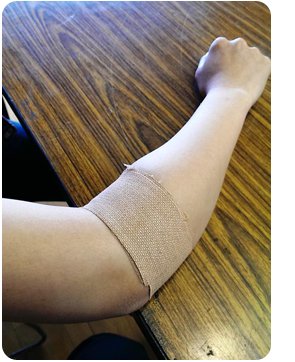 |
The chance of suffering tennis elbow can be |
2. Warm up properly
Before exercising, do proper elbow and wrist warm up exercises. Stretching the tendons can effectively increase the elasticity of soft tissue and thus increase the intensity of exercise the muscles can support. (straighten the elbow joint and bend the wrist down, then gently pull the hand inwards with the other to tighten the forearm tendons; keep the tension for 30 seconds) (as shown in the figure below)
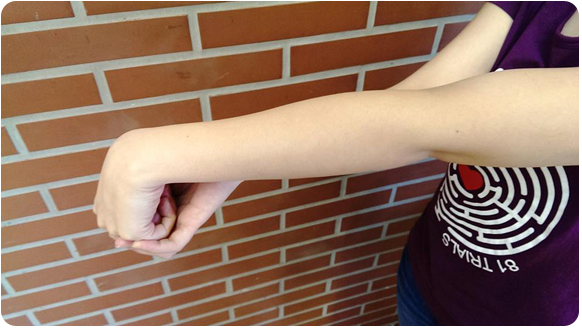
Tendon pulling is an important warm up exercise
3. Increase muscle power by using Kinesio tape
Before competition, Kinesio tape can be applied to the forearm muscle group, increasing muscle power and reducing pressure on the sore point (as shown in the figure below).
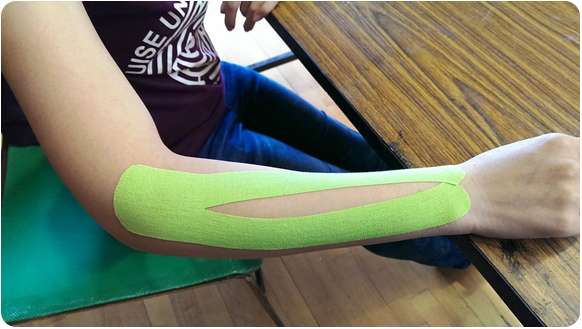
Correct application of Kinesio tape can reduce pressure on the sore point
4. Deep friction massage of the elbow sore point
Deep friction massage can be carried out regularly after hot showers or application of a hot pack and this will reduce the pain of the elbow’s sore point. Place the elbow naturally on a table and use the thumb pulp of the other hand to massage the elbow “slowly and deeply.” Massaging too quickly or not deeply enough will seriously reduce the benefits. Massage ten times each time and be sure not to massage too many times in one go. Deep friction massage will sometimes cause pain;this is normal and all you have to do is rest your arm for a while after massaging (see figure below).
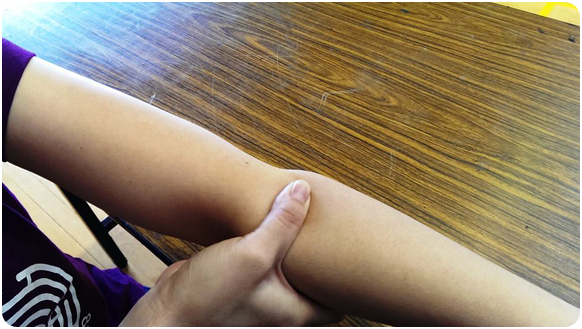
Carry out deep friction massage of the sore point following the principle of “slow and deep”
5. Train the wrist extensor muscle group
Use some idle time every day to train the extensor muscle group. You don’t need to make a trip to the gym, all you need is to fill an ordinary 600 ml PPT bottle with water at home. Then hold the bottle straight out in front of you in one hand, then complete the following movements in sequence.
- Bend the wrist upwards and hold the position for 5 seconds (lift the “dumbbell” up slowly)
- Return to the starting position (bottle held out straight) for 5 seconds
- Bend the wrist down and hold the position for 5 seconds (lower the dumbbell slowly)
Completing the three movements once counts as one time. In each set the movements should be done 15-20 times; do 3-5 sets a day. If this training is done regularly for 6-8 weeks the wrist extensor muscle group’s strength will be increased. (as in the following two figures)
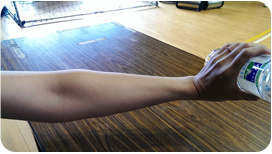 |
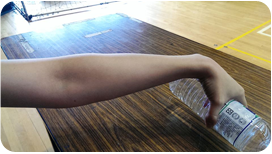 |
|
Strengthen the extensor muscle group through basic muscle training |
|
If tennis elbow is caused by work, we should immediate reduce the workload to avoid more serious inflammation or pain; if an attack is caused by exercise, we should pay attention to the direction we exert force when we exercise and whether our posture is correct. During the rehabilitation period don’t do exercise that involves using the elbow joint for more than one hour at a time. In summary of the above, tennis elbow is a very common orthopedic disease. If we aren’t fully healed and we rush back onto the court when the pain eases we can easily suffer a relapse. It takes patience and determination to cure tennis elbow; apart from enlisting the assistance of a doctor, we also need to cooperate with the course of treatment and not be too anxious to get back in the saddle!
 |
|
||||||||||||||||||||||||||
|
Writter: Hsu Chih-Chung |
|||||||||||||||||||||||||||
( Edit by VICTOR Badminton )









